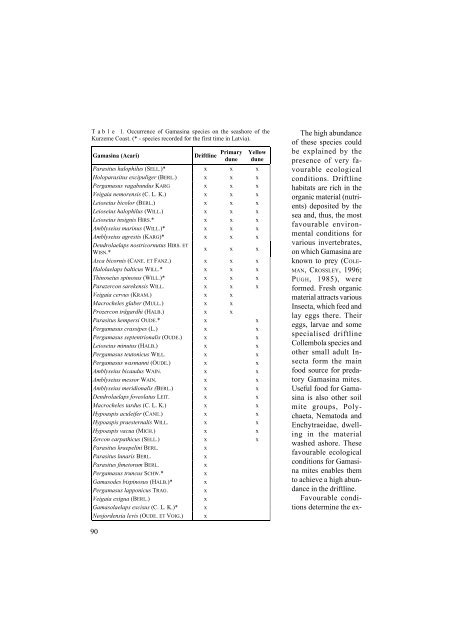spiders (araneae) of the fishpond eulittoral zone - European Society ...
spiders (araneae) of the fishpond eulittoral zone - European Society ...
spiders (araneae) of the fishpond eulittoral zone - European Society ...
Create successful ePaper yourself
Turn your PDF publications into a flip-book with our unique Google optimized e-Paper software.
T a b l e 1. Occurrence <strong>of</strong> Gamasina species on <strong>the</strong> seashore <strong>of</strong> <strong>the</strong><br />
Kurzeme Coast. (* - species recorded for <strong>the</strong> first time in Latvia).<br />
Gamasina (Acari) Driftline Primary<br />
dune<br />
90<br />
Yellow<br />
dune<br />
Parasitus halophilus (SELL.)* x x x<br />
Holoparasitus excipuliger (BERL.) x x x<br />
Pergamasus vagabundus KARG x x x<br />
Veigaia nemorensis (C. L. K.) x x x<br />
Leioseius bicolor (BERL.) x x x<br />
Leioseius halophilus (WILL.) x x x<br />
Leioseius insignis HIRS.* x x x<br />
Amblyseius marinus (WILL.)* x x x<br />
Amblyseius agrestis (KARG)* x x x<br />
Dendrolaelaps nostricornutus HIRS. ET<br />
WISN.*<br />
x x x<br />
Asca bicornis (CANE. ET FANZ.) x x x<br />
Halolaelaps balticus WILL.* x x x<br />
Thinoseius spinosus (WILL.)* x x x<br />
Parazercon sarekensis WILL. x x x<br />
Veigaia cervus (KRAM.) x x<br />
Macrocheles glaber (MULL.) x x<br />
Prozercon trägardhi (HALB.) x x<br />
Parasitus kempersi OUDE.* x x<br />
Pergamasus crassipes (L.) x x<br />
Pergamasus septentrionalis (OUDE.) x x<br />
Leioseius minutus (HALB.) x x<br />
Pergamasus teutonicus WILL. x x<br />
Pergamasus wasmanni (OUDE.) x x<br />
Amblyseius bicaudus WAIN. x x<br />
Amblyseius messor WAIN. x x<br />
Amblyseius meridionalis (BERL.) x x<br />
Dendrolaelaps foveolatus LEIT. x x<br />
Macrocheles tardus (C. L. K.) x x<br />
Hypoaspis aculeifer (CANE.) x x<br />
Hypoaspis praesternalis WILL. x x<br />
Hypoaspis vacua (MICH.) x x<br />
Zercon carpathicus (SELL.) x x<br />
Parasitus kraepelini BERL. x<br />
Parasitus lunaris BERL. x<br />
Parasitus fimetorum BERL. x<br />
Pergamasus truncus SCHW.* x<br />
Gamasodes bispinosus (HALB.)* x<br />
Pergamasus lapponicus TRAG. x<br />
Veigaia exigua (BERL.) x<br />
Gamasolaelaps excisus (C. L. K.)* x<br />
Neojordensia levis (OUDE. ET VOIG.) x<br />
The high abundance<br />
<strong>of</strong> <strong>the</strong>se species could<br />
be explained by <strong>the</strong><br />
presence <strong>of</strong> very favourable<br />
ecological<br />
conditions. Driftline<br />
habitats are rich in <strong>the</strong><br />
organic material (nutrients)<br />
deposited by <strong>the</strong><br />
sea and, thus, <strong>the</strong> most<br />
favourable environmental<br />
conditions for<br />
various invertebrates,<br />
on which Gamasina are<br />
known to prey (COLE-<br />
MAN, CROSSLEY, 1996;<br />
PUGH, 1985), were<br />
formed. Fresh organic<br />
material attracts various<br />
Insecta, which feed and<br />
lay eggs <strong>the</strong>re. Their<br />
eggs, larvae and some<br />
specialised driftline<br />
Collembola species and<br />
o<strong>the</strong>r small adult Insecta<br />
form <strong>the</strong> main<br />
food source for predatory<br />
Gamasina mites.<br />
Useful food for Gamasina<br />
is also o<strong>the</strong>r soil<br />
mite groups, Polychaeta,<br />
Nematoda and<br />
Enchytraeidae, dwelling<br />
in <strong>the</strong> material<br />
washed ashore. These<br />
favourable ecological<br />
conditions for Gamasina<br />
mites enables <strong>the</strong>m<br />
to achieve a high abundance<br />
in <strong>the</strong> driftline.<br />
Favourable conditions<br />
determine <strong>the</strong> ex-
















